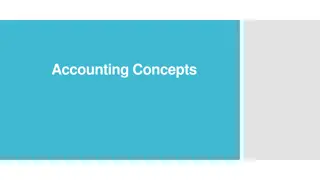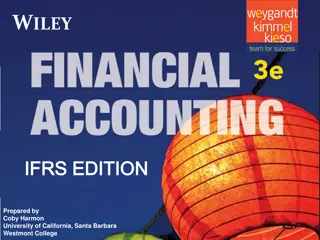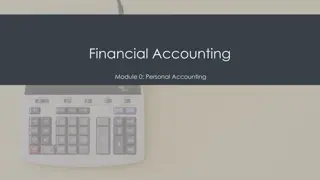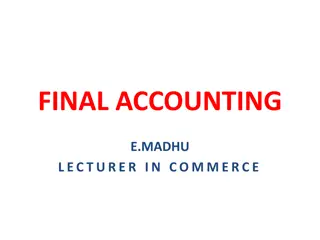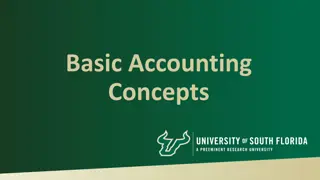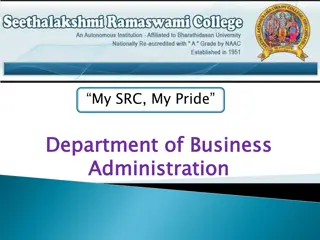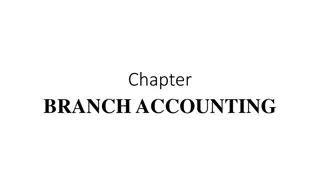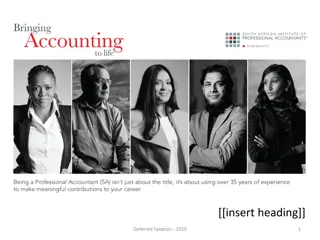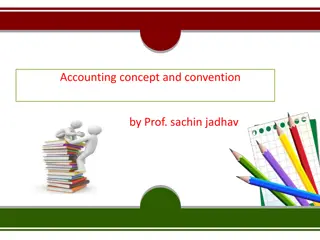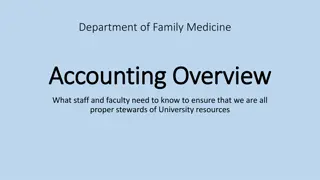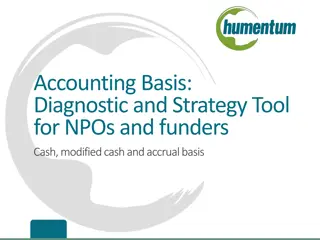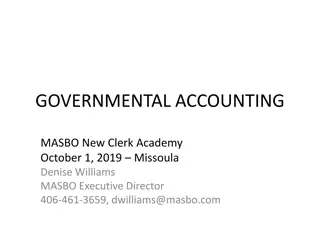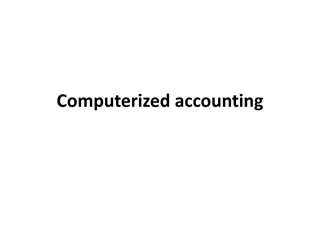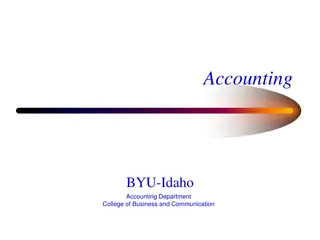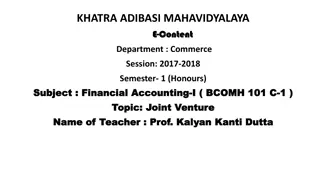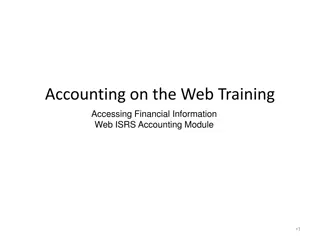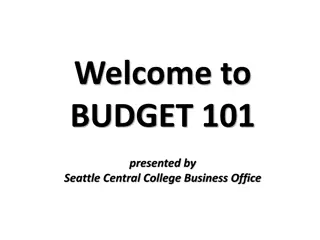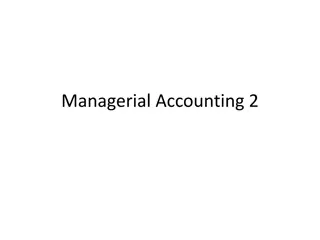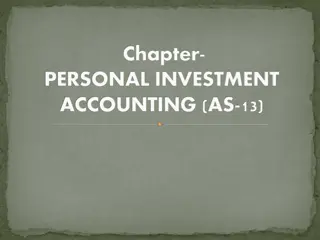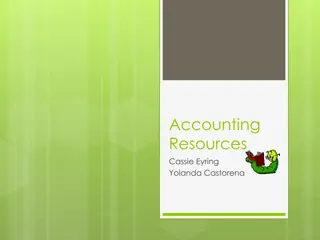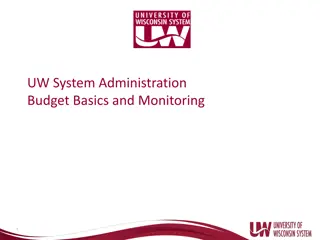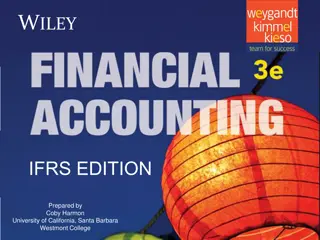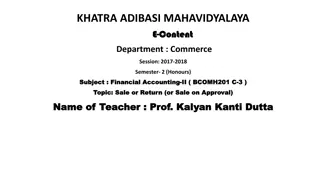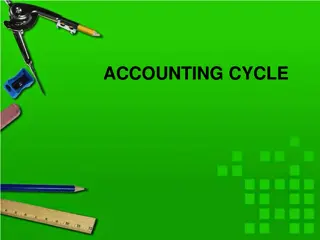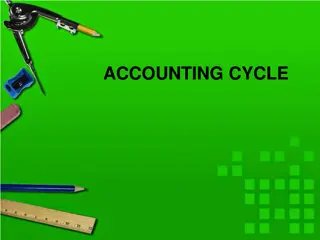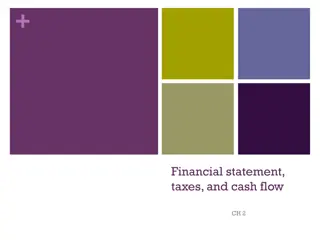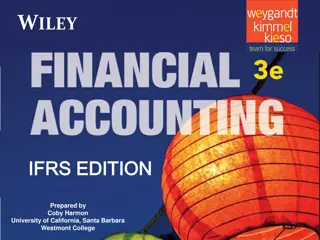Understanding Financial Accounting Principles and Practices
Explore the key concepts in financial accounting, such as assets, owner's equity, liabilities, expenses, and income. Learn about entering transactions from source documents, bank reconciliation, control accounts, and evaluating the results of a sole proprietor at the end of a financial year.
Download Presentation

Please find below an Image/Link to download the presentation.
The content on the website is provided AS IS for your information and personal use only. It may not be sold, licensed, or shared on other websites without obtaining consent from the author. Download presentation by click this link. If you encounter any issues during the download, it is possible that the publisher has removed the file from their server.
E N D
Presentation Transcript
Module 1 Revision with regard to accounting principles ACCOUNTING THEORIES, PRINCIPLES AND CONCEPTS The following concepts are used in accounting: Assets; Owner s equity; Capital; Liabilities Expenses; and Income. www.futuremanagers.com
Module 1 Revision with regard to accounting principles (continued) ENTER TRANSACTIONS FROM SOURCE DOCUMENTS ACCORDING TO THE PERPETUAL INVENTORY SYSTEM Most transactions are accompanied by source documents. Source documents represent the starting point of the recording process, providing detailed information from which each transaction is systematically classified and filed and subsequently entered into the respective books of prime entry. www.futuremanagers.com
Module 1 Revision with regard to accounting principles (continued) BANK RECONCILIATION A bank reconciliation statement is used to reconcile two bank accounts with one another and enter transactions in the bank account of the business that might not have been recorded by the bank, or enter transactions that may have been entered by the bank but have not been recorded by the business. www.futuremanagers.com
Module 1 Revision with regard to accounting principles (continued) CONTROL ACCOUNTS The Debtors Control and the Creditors Control account in the General Ledger is a summary of all individual accounts of debtors that bought goods on credit and purchases made from creditors on credit. At the end of the month, the total balance of debtors in the Debtors Ledger will be compared to the Debtors Control account in the General Ledger, and these two totals should be the same. www.futuremanagers.com
Module 1 Revision with regard to accounting principles (continued) RESULTS OF A SOLE PROPRIETOR At the end of a financial year, the sole proprietor needs to know whether his business made a profit or a loss. To be able to determine this, there are a few additional transactions that need to be performed to be able to obtain the correct figures, namely: Transport costs on goods purchased; Bad debt recovered; and Sale of a fixed asset. www.futuremanagers.com
Module 2 Accounting of a trading organisation according to the periodic inventory system ENTERING TRANSACTIONS IN THE GENERAL LEDGER When using the periodic inventory system, a Purchase account will be opened in the General Ledger where all purchases of trading stock will be debited to. When goods are sold, the amount will be credited against the Sales account. At the end of the financial year, a physical stocktake will be done to determine the value of the closing stock. www.futuremanagers.com
Module 2 Accounting of a trading organisation according to the periodic inventory system (continued) BOOKS OF FIRST ENTRY USING THE PERIODIC INVENTORY SYSTEM If a company uses the periodic inventory system, at the end of the month, the Cash Receipts Journal and Cash Payments Journal will be transferred to the General Ledger. www.futuremanagers.com
Module 2 Accounting of a trading organisation according to the periodic inventory system (continued) CALCULATE THE COST OF SALES USING THE PERIODIC INVENTORY SYSTEM When using the periodic inventory system, the cost of sales is not calculated with each transaction that takes place. At the end of the financial year, a calculation will be done to determine the cost of sales to be able to determine the gross profit of the business. www.futuremanagers.com
Module 2 Accounting of a trading organisation according to the periodic inventory system (continued) TRADING STOCK AS YEAR-END ADJUSTMENT WHEN USING THE PERIODIC INVENTORY SYSTEM When using the periodic inventory system, the only entries done in the Trading Stock account will be at the end of the financial year when Opening Stock and Closing Stock will be transferred to the Trading Stock account. www.futuremanagers.com
Module 2 Accounting of a trading organisation according to the periodic inventory system (continued) CLOSING TRANSFERS WHEN USING THE PERIODIC INVENTORY SYSTEM There are several steps involved when Closing Transfers are done using the periodic inventory system. These include: Closing off the Discount Allowed account to the Sales account; Closing off the Discount Received account to the Purchases account; and Transfer the Sales account to the Trading account. www.futuremanagers.com
Module 2 Accounting of a trading organisation according to the periodic inventory system (continued) FINANCIAL STATEMENTS WHEN USING THE PERIODIC INVENTORY SYSTEM This includes filling out: An income statement for the year end; and A balance sheet of the company. www.futuremanagers.com
Module 3 Departmental accounts using the Periodic Inventory System PURPOSE OF DEPARTMENTAL ACCOUNTS A business may divide its operations in different departments, such as food, clothes and toys. The reason is that management will be able to determine the profitability of each department. If a certain department is not profitable enough, management may decide to close or restructure the department. www.futuremanagers.com
Module 3 Departmental accounts using the Periodic Inventory System (continued) ADJUSTMENT OF SOURCE DOCUMENTS When dividing a business into different departments, it is necessary to adjust the source documents so that a clear indication will be given to which department the source document belongs. By indicating on the source document to which department this income or expense belongs, management will be able to calculate the profit or loss of each department. www.futuremanagers.com
Module 3 Departmental accounts using the Periodic Inventory System (continued) ADJUSTMENT OF BOOKS OF FIRST ENTRY The books of first entry that will be subject to changes are the following: Cash Receipts Journal; Cash Payments Journal; Debtors Journal; Debtors Allowance Journal; Creditors Journal; and Creditors Allowance Returns. www.futuremanagers.com
Module 3 Departmental accounts using the Periodic Inventory System (continued) DEPARTMENTAL TRADING STATEMENT Just as in the case of a business which does not use departmental accounts, the nominal accounts of a business using departmental accounts are closed off at the end of the financial year to the Trading account and the Profit and Loss account. If a business calculates the gross profit of each department, the Trading account and the Profit and Loss account will be divided in the separate departments. www.futuremanagers.com
Module 3 Departmental accounts using the Periodic Inventory System (continued) DEPARTMENTAL INCOME STATEMENT Some businesses do not only divide the Gross Profit into departments but also allocate the expenses to each department to be able to determine the Net Profit for each department when compiling the Income Statement. www.futuremanagers.com
Module 4 Non-profit Organisations THE PURPOSE OF A NON-PROFIT ORGANISATION A non-profit organisation is started to deliver a service on a sport, cultural or recreational level. The main source of income of a non-profit organisation is from subscriptions from members, donations, or events held to raise money for the organisation. www.futuremanagers.com
Module 4 Non-profit Organisations (continued) RECIEPTS, PAYMENTS, INCOME AND EXPENSES All money received in a non-profit organisation will be deposited into the bank account of the organisation and will be seen as receipts. The term income will be used for all the money the organisation should have received for a specific financial period. All payments made by cheque or from cash will be seen as payments. The term expense is used for any payment made that should be explained for a specific financial period. www.futuremanagers.com
Module 4 Non-profit Organisations (continued) SPECIAL ITEMS WITH REGARD TO THE GENERAL LEDGER This includes: An entrance fee (once-off payment) when a new member joins; A membership fee; Affiliation fees; and Honorarium fees. www.futuremanagers.com
Module 4 Non-profit Organisations (continued) SPECIAL FUNDS FOR BEQUESTS AND DONATIONS When a special donation or bequest is made from a member s estate, the donor may specify for what purpose the money should be used. www.futuremanagers.com
Module 4 Non-profit Organisations (continued) ADJUSTMENTS OF MEMBERSHIP FEES AT YEAR END The major income of a non-profit organisation is the membership fees. Adjustments should be done at year end to exclude income applicable on the next financial year and to include income applicable on the current financial year. www.futuremanagers.com
Module 4 Non-profit Organisations (continued) TRADING ACCOUNT Some non-profit organisations will have a shop or bar that sells goods to the members of the organisation. The income and expenses of this shop or bar will be entered in the Trading account where Opening Stock, Purchases, Sales and Closing Stock will be entered. www.futuremanagers.com
Module 5 Cash flow statement of a sole proprietor THE PURPOSE OF A CASH FLOW STATEMENT The purpose of a cash flow statement is to identify the inflow and outflow of cash during a specific period in a business. The cash flow statement is prepared only on cash and includes transactions that will increase or decrease the cash position of a business. www.futuremanagers.com
Module 5 Cash flow statement of a sole proprietor (continued) USERS OF A CASH FLOW STATEMENT The people that will make use of a cash flow statement will be: The owner or management of a business; Credit suppliers. www.futuremanagers.com
Module 5 Cash flow statement of a sole proprietor (continued) THE CONCEPT OF THE CASH FLOW STATEMENT The cash flow statement analyses the inflow and outflow of cash. The income of a business may be generated by delivering a service and the selling of goods. www.futuremanagers.com
Module 5 Cash flow statement of a sole proprietor (continued) NON CASH FLOW ITEMS There are other items in the Income Statement that do not represent cash flow. These items are: Depreciation on fixed assets and Profit/loss with the disposal of and revaluation of fixed assets; Discount received and allowed; Stock written off due to theft or being out of date; and Transfer to and from reserves. www.futuremanagers.com
Module 5 Cash flow statement of a sole proprietor (continued) PROCEDURE TO COMPILE A CASH FLOW STATEMENT The following information will be required to compile a cash flow statement: The Balance Sheet for two consecutive financial periods; The Income Statement of the current financial period; and Calculations and adjustments with regard to fixed assets. www.futuremanagers.com
Module 5 Cash flow statement of a sole proprietor (continued) LAYOUT OF A CASH FLOW STATEMENT The cash flow statement is divided into three parts, namely: Cash flow from operating activities; Cash flow from investing activities; and Cash flow from financing activities. www.futuremanagers.com





